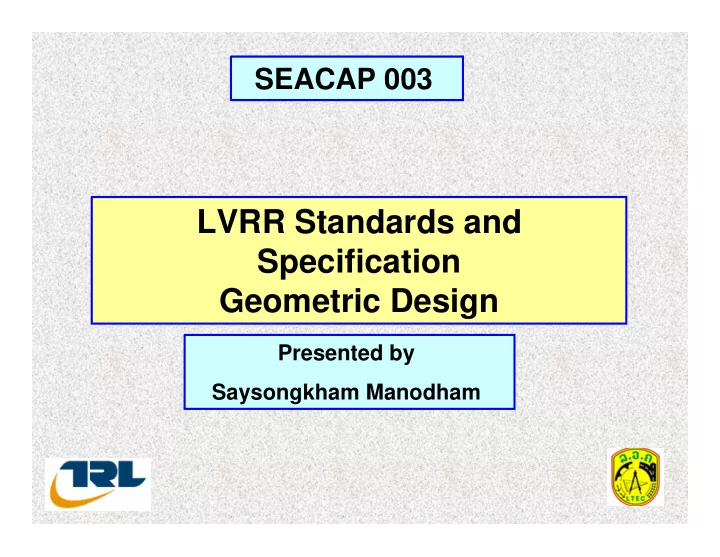

SEACAP 003 LVRR Standards and Specification Geometric Design Presented by Saysongkham Manodham 1
Contributions to Road Deterioration 100 Traffic % Contribution 80 Low Volume 60 Rural 40 Roads Environment 20 % Contribution 0 0 0.25 0.5 0.75 1 1.25 1.5 1.75 2 Traffic (mesa) 2
Design Parameter Description Definition Road system Low volume rural roads For all-year accessibility Classification One-lane roads. Defined by Traffic lane One maximum number of 4- wheeled motorized Maximum 4-wheeled 150 per day vehicles, maximum axle motorized vehicles load and maximum vehicle body width Maximum axle load limit 4.5Tonnes for any vehicle Maximum vehicle body width 2.3m 3
Road Design LVRR Class LVRR Standards Traffic Volume <150 (AADT) Road Design Lao Road Class I II III IV V VI VII Design Traffic Manual Volume (ADT) >8000 3001-8000 1001-3000 301-1000 101-300 51-100 <51 MCTPC VII VIII 2003 AADT 21-51 <21 4
The basic for the LVRR classification Upper limit for LVRR traffic: � 150 motorised 4-wheeled vehicles per day Upper axle load limit: � 4.5 tonnes Upper vehicle width: � 2.3 meters 5
Geometric design is the process whereby the layout of the road is designed to meet the needs of the road users. (ORN 6) To provide: Minimum acceptable level of safety – eg sight distance Economic design Consistency of alignment Design speed Terrain Traffic volume Cross section – widening Gradient Curvature – super-elevation – H & V curvature 6
7 Key elements of a road cross section
Design Parameter Comment Definition Design speed for Terrain: Design speed Defined by Terrain Flat Rolling Rolling Mountainous 50km/h 40km/h 30km/h Minimum 2.5m, Maximum 3.5m Carriageway Defined by vehicle body widths (See Table 4 for selection) and number of non-motorized road Minimum 1m, Maximum 1.5m each side of road (See Table 4 users Shoulder for selection) Flat Rolling Mountainous Defined by terrain with a limit of Maximum gradient 6% for gravel surfacing 10 % 1 6 % 8 % 6 % 2 Gravel Defined by Cross fall surfacing type Sealed 4 % 8
Design Parameter Comment Definition Meeting sight distance, design speeds: Defined by design 50km/h 40km/h 30km/h Stopping sight speed and distance Gravel 130m 100m 60m surfacing type Sealed 100m 70m 50m Horizontal curves, for design speeds: Defined by design Minimum 50km/h 40km/h 30km/h speed and horizontal curve surfacing type for Gravel 110m 70m 40m radius single lane road. Sealed 95m 60m 35m Vertical crest curves, for design speeds: 50km/h 40km/h 30km/h Defined by design Gravel 1528m 890m 370m speed for either Minimum vertical Sealed 1025m 520m 270m crest or sag curves curve radius and by surfacing Vertical sag curves, for design speeds: type 50km/h 40km/h 30km/h Gravel or 390m 250m 140m Sealed 9
Criteria Decision (Shoulder + Carriageway + Shoulder) If maximum vehicle width > 2.3m Use Lao Road Design Manual If maximum plated axle weight > 4.5T Use Lao Road Design Manual If total 4-wheeled traffic AADT > 150 Use Lao Road Design Manual If maximum vehicle width > 1.8m and <2.3m Use 1m+3.5m+1m, total 5.5m road width If maximum vehicle width <1.8m and total AADT of non- Use 1m+2.5m+1m total 4.5m road width motorized road users is <150 If maximum vehicle width <1.8m and total AADT of non- Use 1.5m+2.5m+1.5m total 5.5m road width motorized road users is >150 10
11
Recommend
More recommend